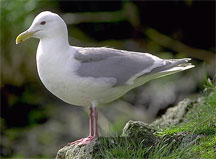Everybody’s Neighbor: The Glaucous-Winged Gull—Summer 2007
We see them eating our refuse, populating our parks, guarding our ferry docks, and painting our cars. They may be seabirds, but many species are ubiquitous on land. You all know who we’re talking about–gulls! Even though we see them everywhere, gulls are still some of the most misunderstood coastal birds. Dirty, trashy, on par with pigeons and starlings? COASST thinks it’s time we stood up for these fascinating and highly adaptable birds.

Do you recognize this bird? Chances are you are familiar with the Glaucous-winged Gull—it's the most common gull in the Pacific Northwest! (T. Good )
One gull species that is definitely worthy of recognition is the Glaucous-winged Gull, the most abundant gull in the Pacific Northwest. Found year-round along the Oregon, Washington, Canadian and Alaskan coastlines and during the winter all the way down to Baja, Mexico, these birds really are “everybody’s neighbor.” COASSTers from California to Alaska find them washed up on beaches year-round. Glaucous-winged Gulls typically make up 2-5% of all COASST finds each year, placing them among the top 10 COASST species.
Far from being drab and dirty, adult Glaucous-winged Gulls are stocky, regal-looking birds with light grey backs and wings complementing a bright white head, breast and belly. Adult birds even sport flashes of color with their red-spotted yellow bills, pink feet, and dark eyes with pink eye-rings.
No such luck identifying juvenile glaucous-wings. Unless you are a gull expert, first year and sub-adult gulls are nearly impossible to distinguish at the species level. Therefore, COASST lumps all of these mottled brown adolescents into one category, the LIGU (Large Immature GUlls).
Looks aren’t everything though–Glaucous-winged Gulls are intelligent as well! Gull expert, Tom Good, of the Northwest Fisheries Science Center, notes that Glaucous-winged Gulls have an ability to recognize specific people. Good reports that gulls at his study sites can become accustomed to the presence of researchers who visit the sites regularly and allow them to approach their nests. However, if a stranger approaches the nests, the gulls become far more disturbed. It seems that gulls know which neighbors are friendly and which could be hostile.
Most people only observe city-dwelling Glaucous-winged Gulls, so many are under the assumption that the only thing gulls eat is garbage. On the contrary, gulls actually have a huge dietary repertoire and are highly adaptable foragers. Glaucous-winged Gulls hunt for live prey such as fish and shellfish, which they catch by wading in the water, or plunge-diving while in flight or swimming. Others will fish for injured or disoriented salmon at dams. Some enterprising birds will become kleptoparasites, stealing food from other birds. A few will even become cannibals, snacking on their neighbor’s chicks. Many will follow fishing boats and feed on discarded fish and bait, while others will “clean up” carcasses on the beach, which is the neighborly thing to do!
Check out these websites for more information about Glaucous-winged Gulls: